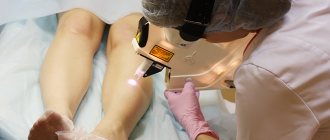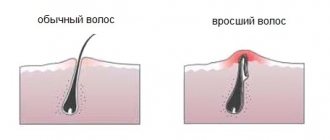From this article you will learn:
- What is laser hair removal
- What types of lasers are used in epilation to remove hair?
- Laser hair removal on the face: stages and nuances of the procedure
- Basics and subtleties of laser hair removal on legs
- Frequently asked questions about laser hair removal
Laser hair removal is a modern method in cosmetology. The use of laser is effective because it contributes to the complete destruction of hair follicles.
Thanks to this procedure, many women received an excellent opportunity to say goodbye to hair in one or another part of the body forever, moreover, the whole process goes quite quickly and, importantly, painlessly. We will tell you more about laser hair removal below.
What is laser hair removal
Laser hair removal is a cosmetic procedure that is carried out using a special device: its beam targets the coloring pigment - melanin. The laser penetrates the hair follicle and destroys its structure from the inside, thus preventing future hair growth. This procedure is most effective on dark-colored hair.
After the first session, you will not get perfectly smooth skin, but the results will still be noticeable. Thin and soft hairs will disappear without a trace, while hard hairs will become less noticeable. Remember that to achieve maximum effect, it is recommended to conduct several sessions, since laser hair removal is a course procedure. This is primarily due to the characteristics and stages of hair development, as well as the affected area. Only a specialist can determine the exact amount. As a rule, this is from 3 to 8 sessions.
Recommended articles on the topic:
- Laser stretch mark removal in a beauty salon: pros and cons of the procedure
- Thermal detoxification: lightness of the body and clear skin
- Laser scar resurfacing is a modern way to get rid of skin imperfections
The service for removing unwanted hair using a laser is provided by most beauty salons, and signing up for them is not difficult. The main thing is to make sure there are no contraindications.
Contraindications
They are divided into absolute and relative.
Absolute
- Oncological diseases;
- Systemic blood diseases;
- Epilepsy;
- Decompensated forms of diabetes mellitus;
- Chronic skin and systemic diseases;
- Infectious diseases;
- Active pulmonary tuberculosis;
- True photodermatitis.
Relative
- Hormonal therapy with certain drugs;
- Pregnancy lactation;
- Herpes in the active stage;
- Skin damage;
- Benign formations with a tendency to develop;
- Diabetes;
- The use of drugs that cause photosensitization of the skin;
- Cardiovascular diseases;
- Having a fresh tan;
- Taking antibiotics;
- Diffuse toxic goiter.
The presence of a tattoo on the area being epilated can also be considered a relative contraindication. The fact is that the dye in the skin, just like the melanin pigment in the hairs, attracts laser radiation. Therefore, in some cases, it is possible to affect both the paint and the vegetation, causing it to fade and blur the outline of the design. If you want to remove hair and keep a bright tattoo, you should pay attention to other methods of getting rid of hair.
Before starting the procedure, Cleo Line specialists always talk with the client and determine whether there are relative or absolute contraindications.
What types of lasers are used in epilation to remove hair?
Several types of laser can be used for hair removal.
- The ruby laser is very effective for fair skin and dark hair color. Its beam penetrates shallowly under the skin. During the process of thermal exposure, unwanted vegetation is eliminated in approximately 5 sessions.
- The Alexandrite laser is considered one of the most effective devices. It is used in a large number of salons, as its effectiveness is quite high. If the procedure is carried out according to all the rules, then there is no pain and complications are practically excluded.
- The peculiarity of the diode laser is that it is able to penetrate into the deep layers of the epithelium, thereby achieving maximum effect. However, the procedure takes longer. Effective when working with any type of hair.
- A neodymium laser allows you to achieve the most lasting and long-lasting (up to 5 years) hair removal effect. Its main distinguishing feature is that the action of the beam is directed directly at the hair follicle and the vessel that nourishes it.
Skin phototypes
Skin phototypes are determined depending on the amount of melanin pigment in the skin, hair and iris of the eyes.
If you know your phototype, it will be easier to choose a laser for hair removal, the frequency of flashes, as well as dermal care products.
The phototype is determined using the Fitzpatrick scale. These are generally accepted standards.
| 1-phototype – Celtic | People have porcelain skin, often with the presence of freckles. People usually have red or blonde hair. Due to the low level of pigmentation, the skin practically does not tan. Laser hair removal is contraindicated. |
| 2-phototype – Aryan or Nordic | Ivory skin, practically no freckles. Light eyes and brown hair. Do not tan for a long time. You can only get a light shade. The best means of hair removal are diode and alexandrite lasers. |
| 3-phototype – dark European | The skin is dark, warm shades. Hair color is most often brown and dark eye color. The tan goes on beautifully and evenly. The efficiency of laser hair removal is high. |
| 4-phototype – Southern European or Mediterranean | The skin is dark with a bronze tint. Hair and eyes are dark. When using alexandrite and diode lasers there is a risk of getting burned; the ideal option is a neodymium laser. |
| 5-phototype – Middle Eastern or Indonesian | Very dark skin and dark, coarse hair. Virtually no sunburn. A diode laser type is suitable here. |
| 6th phototype – African, this also includes Australian aborigines | Rich chocolate-colored skin and thick, coarse hair. Any laser treatments on such hair will be problematic. |
Laser hair removal on the face: stages and nuances of the procedure
Laser hair removal will help get rid of hair on the chin, cheeks or upper lip. They not only make women feel uncomfortable, but can even lower their self-esteem.
Especially considering the fact that it is currently important to grow hair on the head and get rid of it in all other places by any available means. Hair on a woman’s face does not look aesthetically pleasing and spoils even the most attractive appearance. Therefore, in pursuit of beauty, women strive to get rid of unnecessary hair. One of the most effective methods is laser hair removal.
There are, of course, other options. This includes shaving, waxing, sugaring and plucking, and depilatory creams. The options mentioned are the simplest and most tested, but, alas, their results do not last long, and there are also restrictions on use on the skin of the face.
What should you beware of when choosing a salon?
First of all, I would like to open my eyes to what methods of fraud there are in this area.
First, the laser. Now many salons buy cheap Chinese LEDs, which are ineffective. Very often in such salons the prices for procedures are prohibitively low, for example 200 rubles for the upper lip. If this is not a promotion, but a regular price, then you should be wary.
Secondly, lasers have a part (the lamp or the handle as a whole) that needs to be changed. For example, in our laser the handle needs to be changed every 600-700 thousand flashes, since the lamp power drops, and with it the result of the procedure. But many unscrupulous salons neglect this and shine with “empty” lamps. The effect is the same as at home under a light bulb. Particularly cunning salons do the first 1-2 sessions with a normal laser so that the client sees the effect, and then, at the 3-4th session, they can do it with an “empty” handle. As a result, the person is convinced that the problem is in his characteristics, and not in the shortcomings of the equipment, because at first there was an effect.
Thirdly, unscrupulous salons carry out procedures despite clear signs that laser hair removal is not suitable for the client. One day a girl approached us with a request to rid her of the hair on her arms. She went to an expensive clinic for 1.5 years and did not get any effect. At first glance, everything became clear: she had white translucent hair. When we said that, in principle, no laser can treat such hair, she was shocked and said that she could already buy a car with the money she left at that clinic.
Or another case. A very dark man with black hair on his back, stomach and chest came. The master noticed that they were already growing stubble and asked what they were doing before. The client said that he had already gone to laser. The master suggested that there was probably only 1 session at most, because the hair was growing quite thick. But the man admitted that he had already done 15 sessions on Alexandrite in an expensive clinic. Most likely, in order not to burn the skin (Alexandrite can only remove hair on the skin up to the 4th phototype), they turned down the power to the maximum, but it was not enough to burn the hair. As a result, the man started our course from scratch. After the first session, the effect was immediately visible; about 99% of the hair that was in the active stage was gone.
Effect duration
Facial hair grows very quickly (remember men, many of whom are forced to shave every day), and it is necessary to constantly fight for smooth skin. Women have to pluck regrown eyebrow hairs almost every day, and newly epilated mustaches become visible again within a few days after the procedure.
Unlike waxing, shaving, and depilatory creams, which have side effects (ingrown hairs, infections, irritation), laser hair removal has proven to be the most effective and safe method of facial hair removal. All of the above methods of getting rid of unwanted hair have a short-lived effect, while laser hair removal allows you to forget about the problem once and for all, provided you complete a course of procedures.
Minimal impact on skin
The skin of the face is thinner and more delicate than other areas of the body, so methods that are good, for example, for removing hair on the legs, are not suitable for epilating the face. Especially if the skin is prone to irritation and rashes or is simply sensitive. Thus, it is not recommended to use an electric epilator on your face. And most depilatory creams contain harsh chemicals that cause irritation.
Waxing is often practiced to remove facial hair. This method is quite capable of making the skin smooth for one or two weeks, but it has negative sides. Firstly, the procedure is painful, and secondly, the effect of ingrown hair may occur, pinpoint redness and pustular inflammation at the site of hair removal are possible.
Laser hair removal rids the facial skin not only of hair, but also of the troubles that accompany its removal. After all, the effect on the skin is short-term (milliseconds), non-traumatic (the laser destroys the hair structure without affecting the surrounding tissues) and practically does not cause pain or discomfort.
Despite all its advantages and effectiveness, this procedure still has a number of limitations:
- diabetes;
- herpes or other infectious processes in the body;
- oncological diseases;
- the period of bearing a child or breastfeeding;
- exacerbation of allergies;
- abrasions or cuts at the site of intended impact;
- moles on the face;
- tendency to form keloid scars;
- respiratory or viral diseases;
- age up to 18 years.
The procedure is divided into several stages, each of which is carried out by a doctor in a clinic or beauty salon. In order for everything to be successful, preparation for laser hair removal must be done correctly. This issue must be taken very seriously to avoid complications. Consultation with a dermatologist is required (you need to find out about your personal tolerance to the procedure, based on skin and hair color).
After making sure that there are no contraindications, you need to start preparing for it about a week before the procedure. Laser hair removal will be more effective if you adhere to the following recommendations:
- Before exposure to an energy beam, it is recommended to test for possible allergic reactions;
- do not sunbathe;
- 1–2 days before the procedure, adjust the hair length on the desired area of the skin (use a razor for this);
- Do not apply cosmetics to your face on the day of the procedure.
Before hair removal, the doctor who will perform it must examine the client, paying special attention to the skin, and discuss possible risks and contraindications. If there are no obstacles, the procedure proceeds in the following order:
- The specialist examines the skin, determines the phototype, hair structure and adjusts the equipment: the optimal length and laser power.
- During laser hair removal, the client lies on a comfortable couch. His eyes and the doctor's eyes are protected by special glasses.
- If necessary, the cosmetologist trims the hair and treats the skin in the desired area.
- A special conductor gel is applied to the treated area to improve the properties of the laser.
- Depilation. A laser flash, which penetrates the skin to the depth of the hair follicles, heats them in a narrow direction. As a result, they are destroyed, and the hair in this place stops growing. The flash of facial hair removal lasts only a few milliseconds.
- Irradiated skin is treated with a restorative, soothing agent.
After exposure to the laser for several days, it is necessary to create a gentle regime for the face, avoiding mechanical, light and thermal effects. At this time it is not recommended:
- sunbathe;
- use scrubs and peelings;
- apply self-tanner.
In some cases, when the skin at the epilation site is irritated, you need to use soothing and moisturizing creams based on aloe vera.
Hair after laser hair removal that does not fall out immediately will continue to fall out for several more days. An important point: the laser is able to act exclusively on those follicles that are in the active stage, so for final + hair removal, an average of 4-6 sessions will be required.
After the full course, you will forget about the need to fight hair on your body or face. It is extremely rare for some girls to develop single hairs, but if such a problem does arise, then one session a year will be enough to maintain smooth skin.
Can a laser cause cancer?
However, the reason why many women refuse laser hair removal is not the high cost or even the painfulness of the procedure, but the fear of causing cysts and tumors in the body.
This is especially true for hair removal in the armpits - in the immediate vicinity of the mammary glands - or in the bikini area. Oncologist Inna Leontyeva
notes that there is no scientific evidence for this hypothesis.
“The most dangerous for the human body is high-frequency ionizing radiation - X-rays and gamma rays, which are used, for example, in X-ray machines and tomographs. Such radiation actually damages cellular DNA and can trigger the development of a malignant tumor. But laser radiation is not ionizing. It only affects the skin and cannot cause DNA mutations,” states the doctor.
Therefore, all the unpleasant consequences of laser hair removal are usually only superficial: it can be slight irritation, itching, redness of the skin, pigmentation, otherwise a burn if the procedure is performed incorrectly.
The directed laser beam does not penetrate deeper than the hair follicle - 3-5 mm, that is, into the deep cells of the epidermis, and even more so, laser hair removal cannot affect fertility or the condition of internal organs.
Basics and subtleties of laser hair removal on legs
According to modern standards, the beauty of the human body is not only correct proportions and well-trained muscles, but also impeccable smoothness of the skin. One of the indicators of beautiful and well-groomed skin of the legs is the absence of excess vegetation on it.
Laser hair removal will forever eliminate the need to shave your legs every day.
How painful is laser hair removal?
Laser hair removal today is considered a procedure during which there is no pain or discomfort. Because of this, it is used to remove hair not only on the legs, but also on sensitive areas such as the intimate area or armpit area. But everything in the world is relative, and everyone has their own pain sensitivity threshold.
Laser hair removal is a godsend for those who are afraid of traumatic techniques like waxing or sugaring. But compared to shaving with a conventional machine, this method of hair removal does not feel so harmless. It is no coincidence that many resort to pain relief before laser hair removal. If you are not able to endure even the slightest pain, feel free to request anesthesia - embarrassment in this case is inappropriate, mental health is more important.
We recommend
Laser aesthetic cosmetology: the perfect technique for an ideal appearance Read
more By the way, the pain threshold in women differs in different phases of the menstrual cycle, and according to some data, it also depends on the time of day. During PMS, the pain is felt much more intense than after the start of menstruation. So the optimal time for the hair removal procedure (without discomfort) will be the days from the fourth to the seventh cycle. The best time of day is from 15 to 16 hours.
Some modern laser machines have a special attachment for cooling the skin during hair removal - this significantly reduces pain. If there is no such attachment, you can apply ice to your feet before the procedure and hold it for a while to reduce sensitivity.
Preparing for the hair removal procedure
The following steps will help you prepare for laser hair removal on your legs:
- At least 3 weeks before the session, you cannot remove hair from the roots, that is, pull it out. This will make the first procedure as effective as possible.
- For 3 days, you should not use new skin care cosmetics on those areas of the body that will be exposed to the laser. This is due to the possible unpredictable reaction of the skin to an unfamiliar product.
- 2 days before the planned session, you must stop using cosmetics that contain alcohol, so as not to disturb the normal water-fat state of the skin, as this can lead to irritation on it after the procedure.
- 1 day before the session, you need to shave the hair in the area that will be epilated with the laser.
Preparing for laser hair removal of the legs is an important point. This is the key to ensuring that everything goes as efficiently as possible.
How does the session work?
The procedure consists of several stages:
- The specialist checks the condition of the patient’s skin for inflammation, damage and neoplasms.
- A cooling agent is applied to the skin to help reduce discomfort.
- The patient's eyes are protected from laser radiation with special glasses.
- The specialist proceeds directly to the laser hair removal procedure. By pressing the nozzle against the patient's skin, he triggers the generation of an impulse, after which he moves the nozzle and the action is repeated. In this way, the entire affected area is treated.
- At the end, the doctor applies an anti-inflammatory agent to the skin.
Laser hair removal procedure
Our hair has color - it can be black, chestnut, light brown, red. A pigment called melanin is responsible for this: it is what gives the hairs its characteristic shade. Melanin has a peculiarity: it absorbs Laser Hair Removal light waves with a length of about 700–1000 nm - this is exactly what the hair removal laser has. Due to this, the pigment heats up quite strongly.
Since melanin is concentrated in the hair shaft and hair follicle, it also warms them up. This temperature is enough to damage both the rod itself and the blood vessels that feed the follicle.
We recommend
Laser hair removal on the abdomen: contraindications, features of the procedure and care More details
The time of exposure to a hair is a fraction of a second, thanks to which the entire surface of the leg can be treated in a relatively short period of time.
Before starting the procedure, a competent specialist selects the settings of the laser hair removal device individually for each patient (taking into account the area of hair removal, hair color, skin color, etc.). In particular, the pulse parameters (power, energy) are selected in such a way that they are only sufficient to destroy the hair growth zone, and there is practically no effect on the melanin of the epidermis.
Important! Never ask the master to increase the power of the impact. This will not help achieve a better result (fewer sessions, shorter procedure time, etc.). In fact, this approach can lead not only to burns and subsequent scars, but also to more serious consequences.
Which technology has the best price/quality ratio?
Today there are dozens of lasers from different manufacturers. But they can all be reduced to several types: alexandrite, diode, neodymium, Elos, AFT, IPL and IPLASER. We only use lasers with the IPLASER system as they are safe, effective and painless. Our specialists are qualified physicians, as it is important to assess the risk and possibility of laser hair removal individually for each client.
Find out prices for laser hair removal
Number of procedures and interval between sessions
The number of procedures depends on how much “dormant” hair the patient has and the period of its renewal. To achieve a more or less decent result, and this can be considered the need to undergo maintenance procedures no more than once a year, you need from 5 to 10 laser hair removal sessions with an interval of one to two months. Such an interval and frequency of procedures are necessary in order to cover “dormant” follicles that were in the stage of degradation or dormancy at the time of the previous procedure.
Frequently asked questions about laser hair removal
1. How long does it take for hair to fall out after laser hair removal?
The principle of operation is the effect of laser radiation (light wave of a certain length) on the melanin pigment present in the hair. As a result, heated melanin, which has absorbed light energy, destroys the hair growth zone and the vessels feeding the hair follicle. The hair shaft, deprived of nourishment, disappears along with the root. After laser hair removal, hair falls out after about 7-10 days.
2. How long does hair not grow after laser hair removal?
It depends on individual characteristics. After laser hair removal, hair grows more slowly, and the result of completing the full course is a total elimination of unwanted hair. So, in the worst case, you will need to visit a cosmetologist’s office 1-2 times a year to remove individual “instances”.











